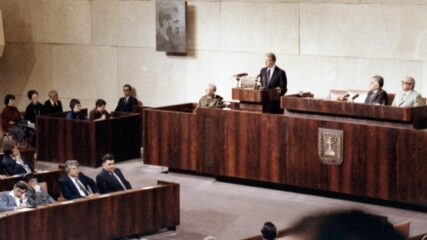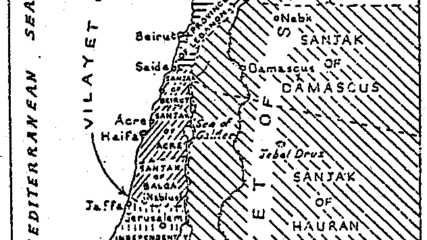The Jordanian, Israeli, Palestinian Triangle
Ken Stein
January 27, 2023
From the June 1967 War, when Israel captured lands on the West Bank of the Jordan River, portions of Jerusalem, the Gaza Strip and the Golan Heights, these territories became part of Israel’s future. Previously all the West Bank and a portion of Jerusalem were governed by Jordan; the Gaza Strip was administered by Egypt. The Golan Heights had been under Syrian sovereignty. Except for the Golan Heights, these territories had been part of all of Palestine, administered by the British from 1920-1948. The remainder of the territories administered by the British became the State of Israel in 1948. At a UN’s suggestion in November 1947, an Arab state and a Jewish state were to be created within the area of Palestine, on the west side of the Jordan River. Only the Jewish state of Israel was established in this area. No reference for resolving Palestinian or Jewish nationalism was made by the UN to include the area on the East Bank of the River, that constituted Jordan. In reaction to the UN Resolution, Arab states and the Palestinians rejected having a Jewish state in their midst. After the ensuing war between Israel and her neighbors, no peace treaties were signed to end the conflict between them. From the war, hundreds of thousands of Palestinian and Jewish refugees were created, including a fast influx of Palestinian refugees who settled on the East Bank, forcing Jordanian leaders policy considerations to take into account its large Palestinian population.

In 1964, the Palestine Liberation Organization was established. Its objectives were to bolster Palestinian Arab nationalism and recruit Arab states to use armed struggle in destroying Israel. Arab states fought Israel in June 1967 to bring about its demise and return Palestinians to the area of the Mandate. Israel persevered in the June war, no lands were liberated as promised by Egyptian President Nassar and other Arab leaders. However, as a result of the 1967 War, Israel quadrupled its size with the acquisition of lands previously held by Egypt, Jordan, and Syria. After the war, no Arab – Israeli peace treaties were signed. For its part, Israel chose to annex that part of Jerusalem that had been held by Jordan previously, particularly to bring Jewish religious sites under Israeli control.

Once again a large number of Palestinians from the West Bank fled into Jordan. Eventually Israel annexed the Golan Heights as well. It did not annex or apply Israeli sovereignty over the Gaza strip and the West Bank areas, in what came to be known as “occupied Palestinian territories.” As the new local authority in these areas, Israel’s presence generated friction, anger, and eventually violence against Israeli administration. When Egyptian – Israeli agreements were signed in the 1970s, none of the “occupied Palestinian territories,” were affected. Put differently, Egypt looked out for its own strategic interests; it did not allow widespread Palestinian or other Arab public dislike for Israel to keep it from achieving a key national objective, and particularly the restoration of Sinai to Egyptian sovereignty. As a result of the 1979 Egyptian – Israeli Peace Treaty, Israel evacuated all of Sinai including all the Jewish settlements it had built there since the 1967 war. In the late 1970s and 1980s, the Carter and Reagan Administrations made repeated concerted efforts to urge the PLO recognize Israel and open negotiations with them. Those efforts failed. And as they failed, Israel continued to build settlements in the territories, In the 1980s, tensions between Palestinians and Israelis steadily rose, dotted by violence.
In November – December 1987, Palestinians took to the streets with civil and violent protest against Israel’s administration, in what came to be known as the “intifadah.” Palestinians were particularly angered by the confiscation of private lands and the travel restrictions imposed upon them.
Dating back to the 1930s, Jordanian and Palestinian leaders have had a history of very tense relations between them. Central to the discord between them was competition for influence and control over Palestine’s geographic future. Likewise, for over half a century, Israeli and Jordanian leaders met privately despite not having diplomatic relations. Their agendas included sharing the Jordan River waters, security issues along their shared 300-mile border, and the impact that rising Islamic radical identities had upon Arab populations under their respective jurisdictions. Inevitably, at the top of their shared agendas were discussions about the force and directions of Palestinian nationalism because its oscillating strengths directly impacted the security of both states. Indeed, it was vigorous and violent assertions of Palestinian nationalism in the intifadah that caused King Hussein to disengage from the West Bank
In a July 28,1988 speech, King Hussein announces that Jordan would administratively disengage from the West Bank. He saw the angry and resurgent Palestinian nationalism as a threat to his kingdom. He saw an influx of Soviet Jewish refugees immigrating to Israel who might settle in the West Bank and could thereby further raise Palestinian national ire. In the 1980s already, Hussein had heard more frequently from Israeli politicians that they wanted to resolve the matter of Palestinian self-determination by advocating that Jordan is Palestine. In this 1988 speech, King Hussein clearly said, “Jordan is Jordan and Palestine is Palestine.” Disassociation from the West Bank ensured strengthening Jordan’s geographic national identity on the East Bank of the Jordan River, essentially withdrawing political competition with the Palestinians and the PLO. His view was that if the Palestinians sought self-determination that they had to negotiate with Israel directly, not through Jordan as an intermediary. Of course, Jordan was terribly interested in the outcome of those negotiations if they materialized, but Jordanian land was not going to be part of that future negotiating equation. Once again, the national interests of an Arab state, Jordan (like Egypt in 1979) took precedence over fostering and in this case confronting Palestinian national aspirations.
Coincidently, Hussein’s disassociation from the West Bank, occurred just three weeks before Hamas, the radical Islamic Palestinian organization issued its Charter emphatically stating that any recognition or negotiation with Israel was prohibited. Now, the PLO found itself negotiating to wrest land from Israel, as the international community demanded as a prerequisite for PLO to enter negotiations, unconditional recognition of Israel. Palestinians had a choice to align with absolute refusal to accept Israel as implored by Hamas, or support the PLO, whose leaders wanted to control some land areas from the former the British Mandate and would recognize Israel to unfold a negotiating process. As immediate consequence of the 1991 Gulf War, another large group of Palestinians fled to Jordan. This time Arab Gulf states expelled 350,000 Palestinians when PLO leader Arafat recognized Saddam Hussein’s invasion of Kuwait which threatened other Gulf states.
Subsequent to Jordan’s disengagement, the PLO opted to engage in diplomacy with the U.S. and afterwards, secretly with Israel. For the PLO, Jordan was no longer a political obstacle to future control of land west of the Jordan River, namely the future of the West Bank. In September 1993, the PLO and Israel mutually recognized each other and then signed the Oslo Accords. These agreements gave the PLO a chance at self-governance over a limited amount of land. No Palestinian state was promised in the Oslo Accords, though the Palestinians hoped that would evolve.

Without worrying about the West Bank’s future, King Hussein moved quickly to sign a peace treaty with Israel in October 1994. That treaty has remained in force to the present, with Jordan benefitting enormously economically from the US decision to provide to Jordan most favored nation trade status. From the late 1980s forward, the Palestinian political arena has remained in an active spin cycle about whether to compromise with Israel, or absolutely reject it as a legitimate state. Meanwhile, Israel has continued to solidify its presence in the West Bank while Jordan continues to bolster its national identity on the East Bank of the Jordan River. A significant element in the UAE and Bahrain signing the Abraham Accords with Israel in September 2020, was its promise not to annex West Bank lands. In January 2023, according to survey research undertaken by the Palestine Center for Policy and Research support for a two state solution among Palestinians and Israelis has declined to just one-third on each side.
Ken Stein, January 29, 2023









